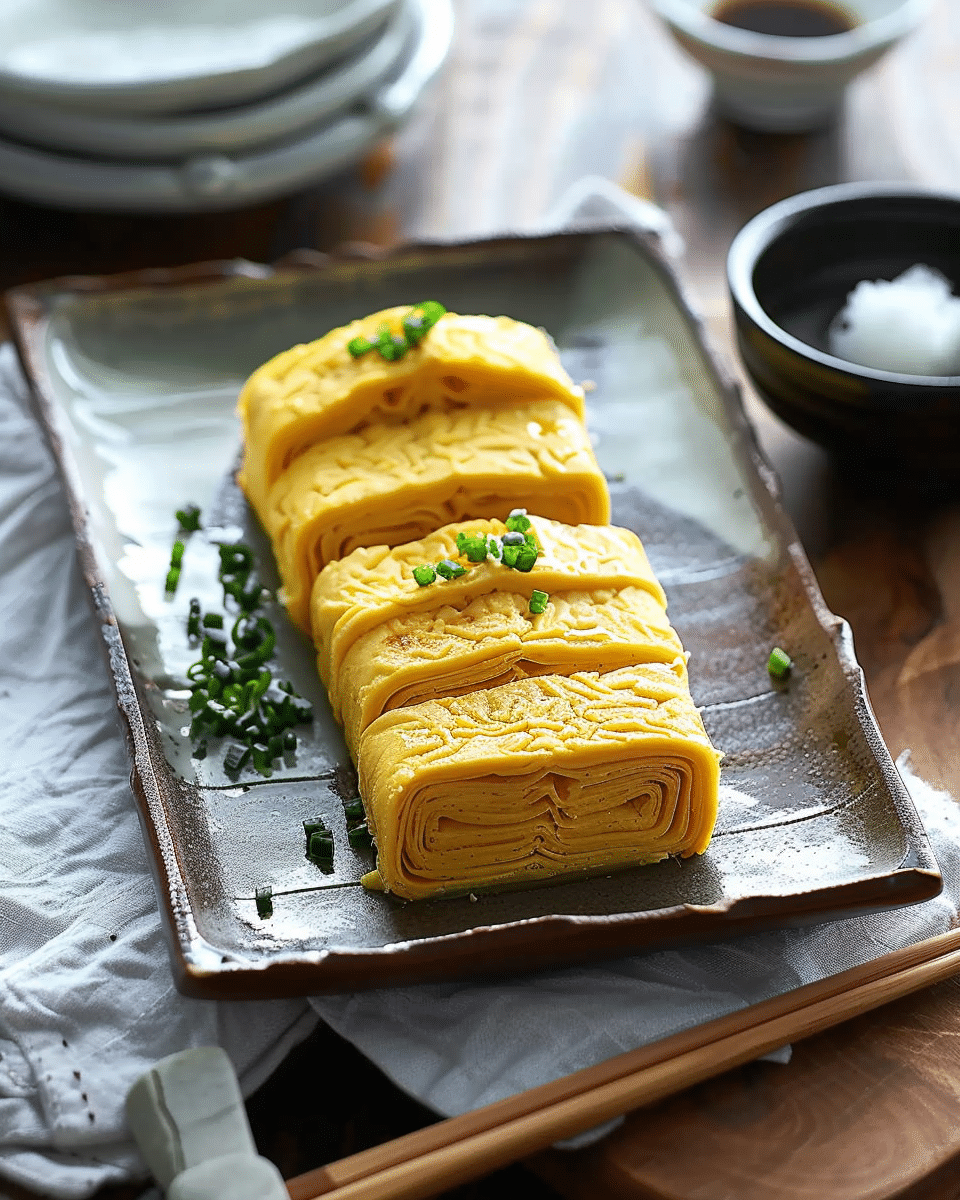Tamagoyaki is a soft, slightly sweet rolled omelet that I love making for breakfast, lunch, or even as a side for dinner. Its delicate layers, mild sweetness, and savory undertones from dashi and soy sauce make it a comforting dish that feels both light and satisfying. Although it looks intricate, once I got the hang of the rolling technique, it became a fun and rewarding recipe I keep coming back to.

Why You’ll Love This Recipe
I enjoy tamagoyaki because it’s a simple recipe with just a few ingredients, yet it delivers such a satisfying taste and texture. The gentle sweetness balances the savory dashi, and the rolled layers create a beautiful swirl inside. I like that I can serve it hot, room temperature, or even cold from the fridge—making it perfect for busy mornings or bento lunches. Once I learned the basic method, I started adding my own fillings like scallions, cheese, or seaweed, which makes it even more exciting.
Ingredients
(Here’s a tip: Check out the full list of ingredients and measurements in the recipe card below.)
-
Warm water
-
Instant dashi powder (like Ajinomoto Hondashi)
-
Large eggs
-
Sugar
-
Kosher salt
-
Soy sauce
-
Mirin
-
Canola oil
-
Grated daikon for serving (optional)
Directions
-
I start by making the dashi stock, dissolving the powder in warm water until it’s smooth.
-
In a medium bowl, I beat the eggs with sugar and salt, being careful not to create too many bubbles.
-
I stir in the dashi stock, soy sauce, and mirin until well combined. For a smoother texture, I sometimes strain the egg mixture through a fine mesh sieve.
-
I oil my tamagoyaki pan (or a small nonstick skillet) lightly with a folded paper towel dipped in oil, then heat it over medium before lowering to medium-low.
-
I pour in a thin layer of egg, let it set until the top is slightly wet, then roll it to one side using a spatula or chopsticks.
-
I add more oil if needed, pour another thin layer of egg, making sure it flows under the first roll, cook until nearly set, then roll again in the opposite direction.
-
I repeat until all the egg mixture is used, making two omelets in total.
-
I let them cool slightly before cutting into 1-inch slices and serving with optional grated daikon.
Servings and timing
This recipe makes 4 servings and takes about 20 minutes in total—10 minutes for prep and 10 minutes for cooking.
Variations
-
I sometimes add finely chopped scallions or chives for a fresh, aromatic flavor.
-
For a richer bite, I like adding shredded cheese before rolling.
-
Chopped nori or cooked spinach can bring in extra color and nutrients.
-
I’ve also tried it with flaked cooked salmon for a heartier version.
storage/reheating
I store leftover tamagoyaki in an airtight container in the refrigerator for up to 3–4 days. I often enjoy it cold straight from the fridge, but if I want it warm, I heat it in the microwave in short 15-second bursts to avoid overcooking.
FAQs
How do I keep tamagoyaki from browning?
I cook it on medium-low heat and avoid leaving it in the pan too long. This keeps the texture tender and the color bright yellow.
Can I make tamagoyaki without dashi?
Yes, I’ve made it with low-sodium chicken stock instead, but the flavor changes. It’s still tasty, just less traditionally Japanese.
What kind of pan is best for tamagoyaki?
I prefer a rectangular tamagoyaki pan because it makes rolling easier, but a small nonstick skillet works well too.
Can I freeze tamagoyaki?
I don’t recommend freezing it, as the texture can become watery and rubbery when thawed.
How do I prevent the first roll from breaking?
I make sure the egg is mostly set but still slightly wet before rolling. If it does tear, I just keep going—the next layers will hold it together.
Conclusion
Tamagoyaki is one of those dishes that looks impressive but is surprisingly easy once I practice a few times. I like that it’s versatile, works with many fillings, and fits into any meal of the day. Whether I’m packing a bento or enjoying a quiet breakfast, this delicate rolled omelet always feels like a little handmade treat.

Tamagoyaki (Japanese Rolled Omelet)
5 Stars 4 Stars 3 Stars 2 Stars 1 Star
No reviews
- Author: Olivia
- Total Time: 20 minutes
- Yield: 4 servings
Description
A delicate Japanese rolled omelet made with eggs, dashi, soy sauce, and mirin, offering a perfect balance of sweet and savory flavors in soft, layered slices.
Ingredients
1/4 cup warm water
1/4 teaspoon instant dashi powder (like Ajinomoto Hondashi)
4 large eggs
2 teaspoons sugar
1/4 teaspoon kosher salt
1 teaspoon soy sauce
1 teaspoon mirin
Canola oil, for cooking
Grated daikon, for serving (optional)
Instructions
- In a small bowl, dissolve dashi powder in warm water to make dashi stock.
- In a medium bowl, beat the eggs gently with sugar and salt, avoiding excessive bubbles.
- Stir in the dashi stock, soy sauce, and mirin until well combined. For extra smoothness, strain the mixture through a fine mesh sieve.
- Lightly oil a tamagoyaki pan or small nonstick skillet using a folded paper towel. Heat over medium, then reduce to medium-low.
- Pour in a thin layer of the egg mixture. Let it set until the top is slightly wet, then roll it to one side using chopsticks or a spatula.
- Add more oil if needed, pour in another thin layer of egg (ensuring it flows under the first roll), cook until almost set, then roll in the opposite direction.
- Repeat until all the egg mixture is used, making two omelets total.
- Cool slightly before slicing into 1-inch pieces. Serve with grated daikon if desired.
Notes
- Cook on medium-low heat to prevent browning and maintain a bright yellow color.
- A rectangular tamagoyaki pan makes rolling easier, but a small nonstick skillet also works.
- Add scallions, cheese, nori, spinach, or flaked salmon for variety.
- If the first roll tears, keep going—later layers will hold it together.
- Prep Time: 10 minutes
- Cook Time: 10 minutes
- Category: Breakfast
- Method: Stovetop
- Cuisine: Japanese
Nutrition
- Serving Size: 1/4 recipe
- Calories: 110
- Sugar: 2g
- Sodium: 180mg
- Fat: 8g
- Saturated Fat: 2g
- Unsaturated Fat: 5g
- Trans Fat: 0g
- Carbohydrates: 2g
- Fiber: 0g
- Protein: 7g
- Cholesterol: 185mg







